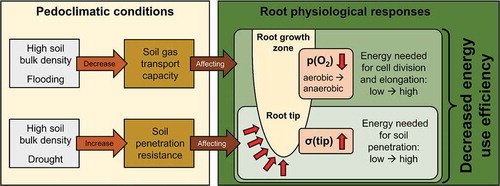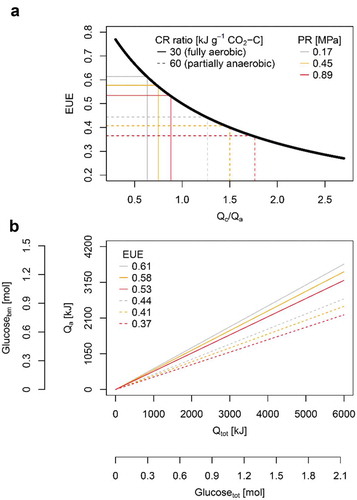Figures & data
Figure 1. Conceptual overview illustrating relationships between pedoclimatic conditions and energy use efficiency of root growth. High bulk density and flooding decrease soil gas transport capacity, resulting in (i) decreased cellular oxygen concentration (p(O2)) in the root growth zone and (ii) a shift from aerobic to anaerobic metabolism. Furthermore, high bulk density and drought increase soil penetration resistance, leading to higher mechanical stress at the growing root tip (σ(tip)). Energy requirements of root growth increase in response to low p(O2) and high σ(tip), resulting in higher amounts of energy allocated to catabolic than anabolic processes and thus in a decrease of energy use efficiency.

Figure 2. Effects of calorespirometric ratio and soil penetration resistance (PR) on (a) the energy allocated to root respiration (catabolic energy Qc; Eq. 1), (b) the energy allocated to root growth (anabolic energy Qa; Eq. 2), and (c) the ratio between Qc and Qa. Calorespirometric ratio of 30 and 60 kJ g−1 CO2-C represent fully aerobic and partially anaerobic conditions, respectively. Calculations are based on mean values (n = 5) of 16 wheat genotypes taken from Colombi et al.Citation2.

Figure 3. (a) Energy use efficiency (EUE; Eq. 3) as a function of the ratio between energy allocated to root respiration (catabolic energy Qc; Eq. 1) and root growth (anabolic energy Qa; Eq. 2) at different calorespirometric ratio (CR ratio) and levels of soil penetration resistance (PR). CR ratio of 30 and 60 kJ g−1 CO2-C represent fully aerobic and partially anaerobic conditions, respectively. (b) Qa as a function of the total energy required for root growth (Qtot; Eq. 3) at different EUE. Carbohydrate equivalents for Qa (Glucosebm) and Qtot (Glucosetot) were calculated using the molar combustion enthalpy of 2813.6 kJ mol−1 glucose. CR ratio and soil penetration resistance are indicated by line style and color, respectively. All calculations are based on mean values of 16 wheat genotypes and five replicates (n = 80) taken from Colombi et al.Citation2.

